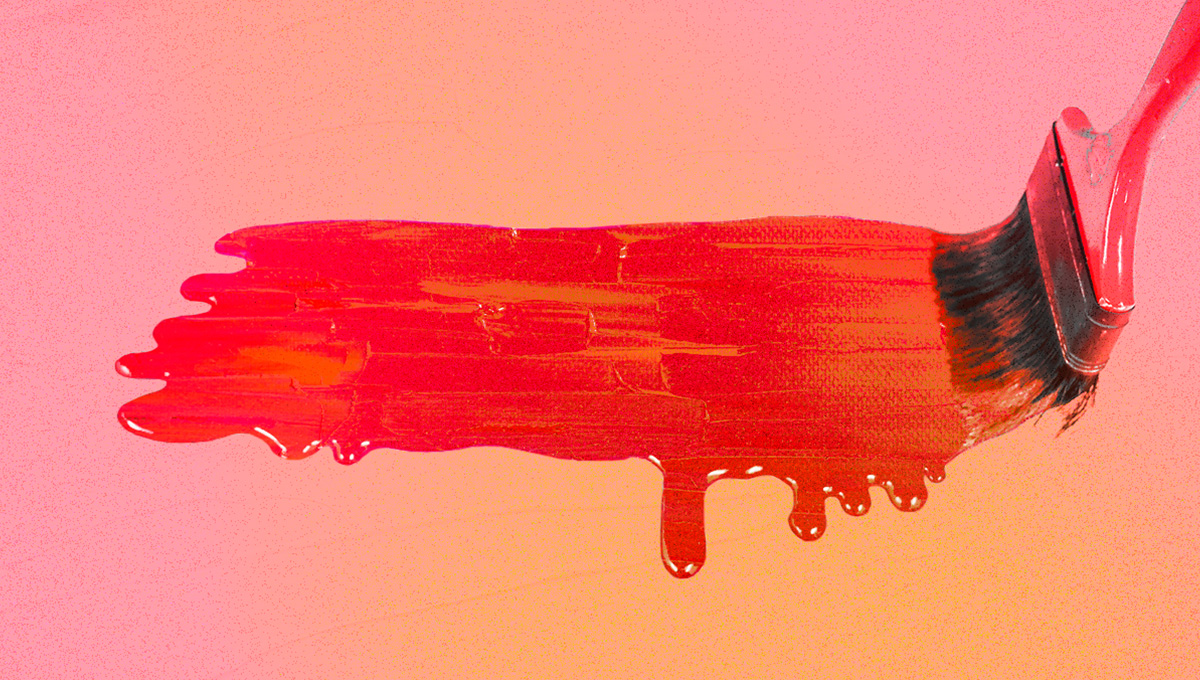Imagine someone handed you some art supplies and asked you to depict the death of Jesus. Then, they told you your artwork would be viewed by thousands of people.
Where would you start? How would you stage the scene? What point would you focus on? What would you hope people would feel when they look at it? How would you communicate the significance of that event?
Innumerable artists, Christians and non-Christians, have taken a crack using the art style of their day to help people have a spiritual experience through their visualization of the crucifixion. Artists until the end of time could paint the Crucifixion of Jesus in new ways because the depth of significance of this event cannot be exhausted.
Here are five paintings that I have found help me to reflect on the crucifixion in richer ways.
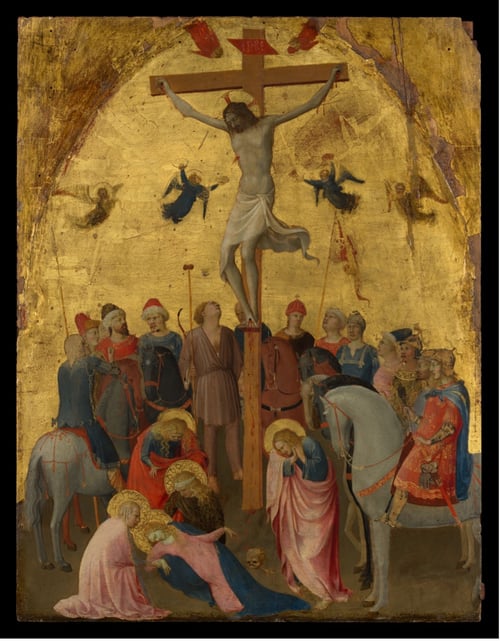
Fra Angelico, The Crucifixion, c.1420-1423
- Fra Angelico was a Dominican friar in Rome, painting during the late Medieval/early Renaissance era.
- He sees the crucifixion as an event of significance for the spiritual world, using gold in the sky and halos to pull us into the “holy realm.”
- Angels mourn the death of Jesus, and Jesus’s followers join in the angelic lament with Mary even collapsed in grief.
- The Roman soldiers stand around with varied reactions: indifference, interest, pity, or awe.
Fra Angelico invites you to see the crucifixion as a supernatural event and challenges you to decide how you will respond.
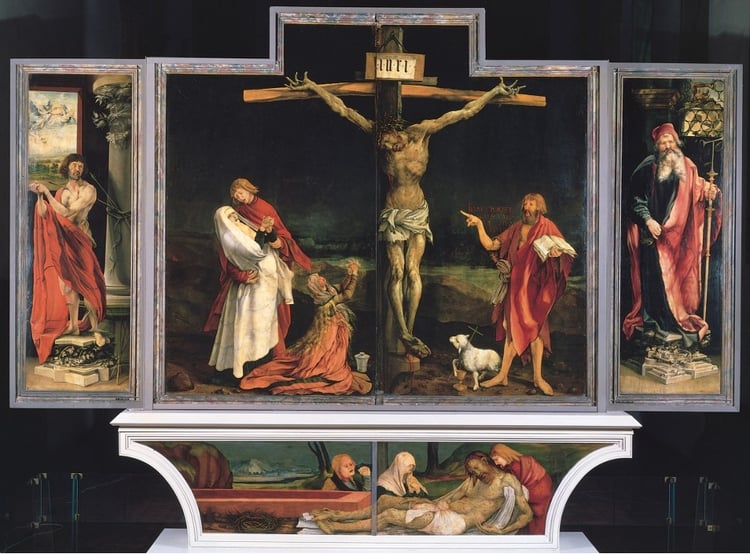
Matthias Grunewald, The Crucifixion, the Isenheim Altarpiece, 1512-1516
Grunewald’s Crucifixion
- Grunewald was a Northern Renaissance painter commissioned to paint an altarpiece for a chapel in a hospital run by a monastery.
- The hospital treated many who suffered from a skin disease that caused convulsions and gangrene.
- Jesus’s suffering on the cross is depicted in horrific ways: contorting his hands and feet (much like convulsions), thorns covering his body, muscles straining, body emaciated.
- The suffering is intensified by the black sky.
- Sufferers could come to be reminded that they worship someone who can identify with their sufferings.
Grunewald helps you remember that you pray not to an indifferent God but to one who took on flesh to suffer more than you can imagine. So he sees you in your suffering.
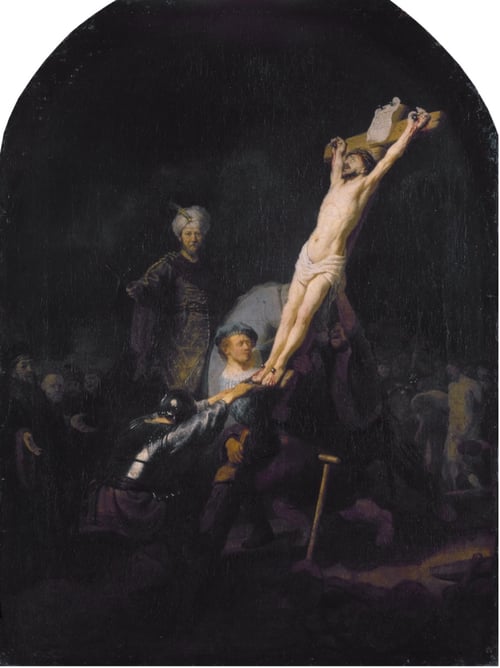
Rembrandt van Rijn, Raising of the Cross, 1633
Rembrandt’s Raising of the Cross:
- Rembrandt was a Baroque painter, employing hallmarks of the Baroque style in his work: stage lighting, triads, and action.
- This painting shows the cross at the moment it is being raised.
- The light focuses on three people:
- The most light is on Jesus as he looks into heaven, seemingly saying “Father, forgive them. They know not what they do.”
- The light also shows a man wearing a seventeenth-century light blue beret despite the first-century Palestinian setting.
- More faintly lit is a man in the back with a white turban
- The man in the beret is Rembrandt. He depicts himself raising the cross, acknowledging his own guilt that contributed to why Jesus had to die.
- The man in the turban looks out at the viewer, pulling you into the event.
Rembrandt doesn’t allow the crucifixion to remain a distant historical event or an interesting story. Instead, he puts himself into the painting and draws you into it, too. Rembrandt wants you to recognize the role of your sin in Jesus’s death… while gazing on a Jesus who’s praying for you: “Father, forgive them. They know not what they do.” (Luke 23:33-34)
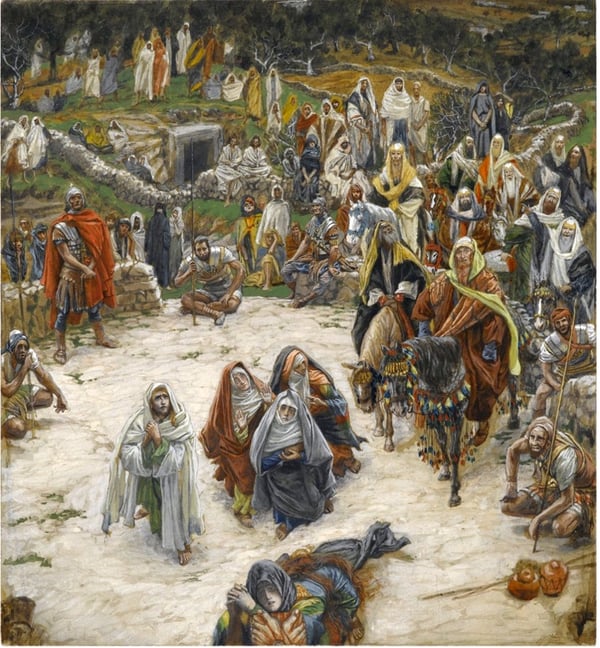
James Tissot, What Our Lord Saw from the Cross, c.1890
Tissot’s What Our Lord Saw from the Cross:
- Tissot painted in a French Impressionist style influenced by Japanese art.
- When Tissot was almost 50, he experienced a renewal of his Catholic faith.
- He traveled through the Middle East to grasp the landscape and clothing and painted a series of paintings depicting events from the Old and New Testaments.
- Rather than seeing the crucifixion as a mere symbol of an idea or a truth about the general human condition, Tissot depicted the crucifixion as a historical event happening at a particular time in a particular culture
- Instead of showing us Jesus, Tissot turns the camera view to show what Jesus saw looking out at the crowds.
- From Jesus’s perspective, we see…
- A centurion standing off to the left, sobered by what he’s witnessing.
- A crowd of Jewish leaders on horses mocking and disdaining Jesus.
- A handful of women with John, troubled at the foot of the cross.
- And many others standing at a distance not wanting to get too close.
- This is the human mess for whom Jesus, out of mind-bending compassion, chose to endure the cross. By seeing what he saw from the cross, Jesus’s grace is on display.
Tissot forces you to contemplate how you would respond if you had been there. Would you mock, stand far off at a safe distance, or to weep at the foot of the cross?
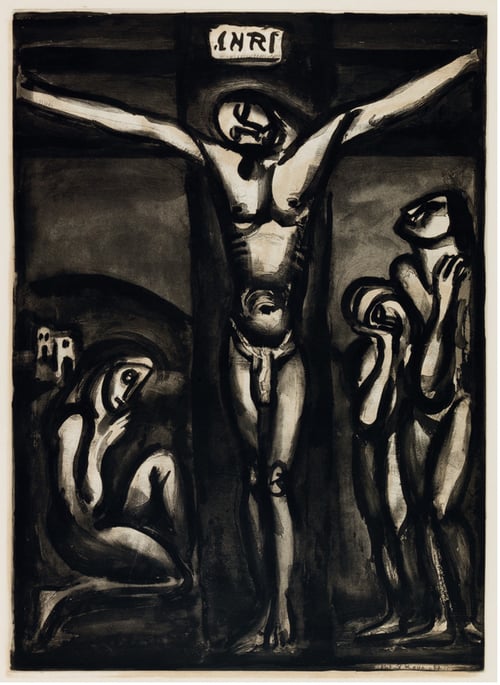
Georges Rouault, Crucifixion, Miserere, 1917-1927
Before World War I, Western society was marked by optimism about the human condition, believing that humanity would continue to get better and better. The evils of the first World War upended these expectations, striking an emotional blow that came through in artworks from the interwar period.
- Rouault was a French painter in the Fauvist and Expressionist style.
- With this piece, he wanted to create an emotional response more than depict the event with photographic accuracy.
- Rouault made a series of copper engravings showing the misery humanity creates for itself. A set of engravings on Jesus’s death enter at the end of the book.
- The crucifixion is positioned as the height of our “dehumanizing” with dark smears emboldening the emotion.
- Jesus’s form is dehumanized, as are those of the mourners crumpled at the foot of the cross.
- This painting illustrates how rebellion against God makes us less human, resulting in our misery.
- After this time, Rouault paints more about Jesus’s resurrection than his crucifixion.
Rouault forces you to feel your guilt and acknowledge the ways you have dehumanized others, leaving misery in your wake. However, this is not an invitation to self-hating despair. For Rouault—and for you—Jesus’s crucifixion is not solely the result of our dehumanization, but the answer to it.
These five artists from different periods use the styles of their day to pull and shock you into contemplating the profound meaning of the crucifixion of Jesus.
Here are a few questions to help you reflect on and commemorate what Jesus did in dying on the cross:
- Which painting stretches your understanding of the crucifixion?
- How do these paintings to help you mourn this Good Friday?
Consider the human evil that necessitated Jesus’s death, your own part in that human evil, the suffering Jesus innocently endured to save us, or the coldness of your own heart towards what he did for us.
- How do these paintings stir up new wonder and gratitude in your heart about what Jesus did on the cross?
Continue preparing your heart for Easter by reading this post from Anna Lynne. She'll guide you step by step on how to use the rhythms and themes of Easter Weekend to plan for Easter Sunday.
